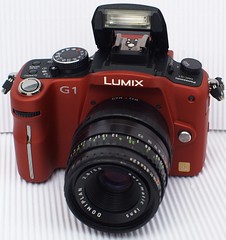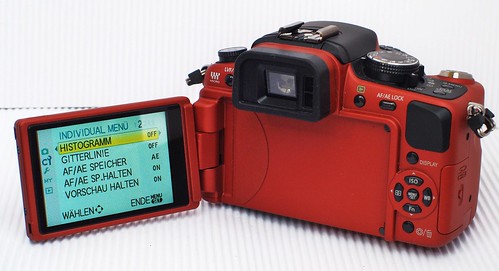Panasonic Lumix DMC-G1
 Lumix G1 with an adapted manual-focus Meyer lens (Image rights) |
 images by Uwe Kulick (Image rights) |
The Panasonic Lumix DMC-G1 is a mirror-less digital system camera and Panasonic's first camera built around the Micro Four Thirds format co-developed with Olympus.
The Panasonic Lumix DMC G1 is a 12.1 megapixel digital system camera for interchangeable lenses of the Mico 4/3 system. It is the first in its class from Panasonic, and in a very real sense, the first in its kind from any manufacturer. That means that it has a high-resolution electronic viewfinder showing the actual image caught by the image sensor. The finder has an ocular with diopter-correction facility. Behind the finder optics is a 1.400.000 Pixel extra display. The common 460.000 Pixel digicam display in the camera back offers also high resolution, and it is tilt- and turnable. The camera has a moveable autofocus area.
The camera delivers fine imaging results. With appropriate diopter setting the finder image is sharp enough for exact focusing. Sometimes that kind of finder is a bit slow when accomodating to fast changing light or focus. Thus an optical finder still has an advantage. But for the amateur market it's now cheaper to produce "100%-viewfinders" of system cameras the electronical way instead in the opto-mechanical way of SLRs and DSLRs.
Further reading
- Panasonic Lumix G1 Review by Simon Joinson, Lars Rehm, Phil Askey, Richard Butler at Digital Photography Review
- Lumix G1 at Olypedia - In German
| Japan Camera Grand Prix | |
|---|---|
| Camera of the year
1984: Nikon FA | 1985: Minolta α-7000 | 1986: Canon T90 | 1987: Canon EOS 650 | 1988: Kyocera Samurai | 1989: Nikon F4 | 1990: Canon EOS 10 | 1991: Contax RTS III | 1992: Pentax Z-1 | 1993: Canon EOS 5 | 1994: Minolta α-707si | 1995: Contax G1 | 1996: Minolta TC-1 | 1997: Nikon F5 | 1998: Pentax 645N | 1999: Minolta α-9 | 2000: Canon EOS-1V | 2001: Minolta α-7 | 2002: Canon EOS-1D | 2003: Canon EOS-1Ds | 2004: Nikon D70 | 2005: Konica Minolta α-7 Digital | 2006: Nikon D200 | 2007: Pentax K10D | 2008: Nikon D3 | 2009: Canon EOS 5D Mark II | 2010: Olympus Pen E-P1 | 2011: Pentax 645D | 2012: Nikon D800 | 2013: Sony DSC-RX1 | 2014: Nikon Df | 2015: Canon EOS 7D Mark II | 2016: Sony α7R II | 2017: Olympus OM-D E-M1 Mark II | 2018: Sony α9 | 2019: Lumix S1R | 2020: Sony α7R IV | 2021: Sony α1 | 2022: Nikon Z9 | 2023: Sony α7R V Special Prize Editor | |